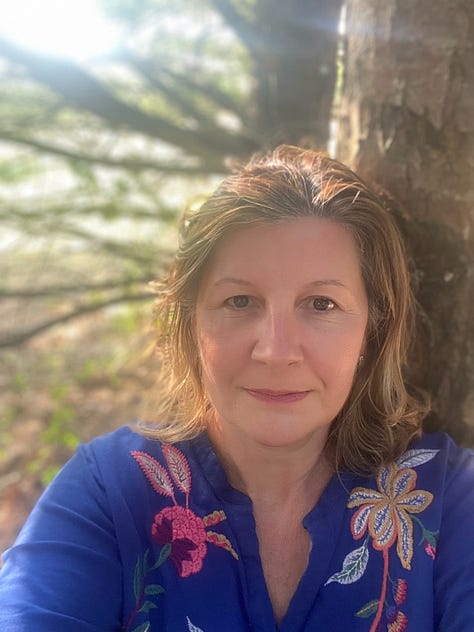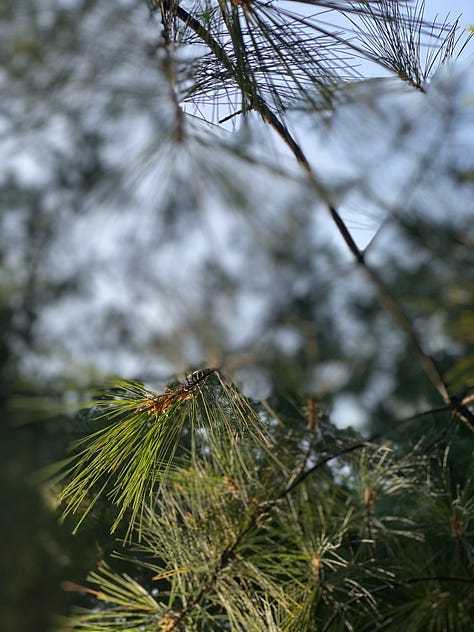How I Broke Up With the “Always Strong” Version of Me
She was competent. She was unstoppable. She was killing me.



I am back in my room, my little writing nook. The desk is the same, the window is the same, even the mug of tea cooling at my side feels unchanged.
What is different is me.
For thirty days, I lived without the glow of the laptop dictating who I should be. No endless chase of "always on." No ceaseless hum of productivity whispering that my worth lived in my output.
But the moment I press the power button, something ancient awakens.
The screen flickers to life, and so do the old circuits inside me. My body tightens. Shoulders round forward. Breath shortens. My mind gallops toward lists, deadlines, expectations—that familiar drumbeat of more, faster, better.
It's as if an invisible switch flips: be strong, be productive, stay on, or else you won't exist.
The transformation is instant. And terrifying.
The Night Everything Cracked Open
I remember the night that shattered everything.
3 AM. Fever burning through me. I found myself crying at my desk, asking the question that changed everything: "Who am I if I'm not producing?"
The vulnerability of that moment terrified me because it revealed how completely I'd outsourced my identity to my environment. I'd become a prisoner of my own competence. The "always strong, always productive" armor I'd worn for years had fused to my skin.
At first, being that person felt like winning. Praise followed me like a shadow. Colleagues admired my stamina. Family leaned on my resilience. Society rewarded my output.
But the longer I rehearsed that role, the less room I had to be anyone else.
When Your Environment Becomes Your Identity
We like to think identity is something we choose.
Neuroscience reminds us that identity is often something we rehearse. Each environment is a stage set, stocked with props and cues that trigger automatic responses we've practiced for years.
Donald Hebb put it bluntly: "Neurons that fire together wire together." The more often a pattern is rehearsed—sit down, open laptop, tighten jaw, become invincible—the stronger it becomes. Myelin sheaths wrap around those circuits like insulation, making them faster, smoother, more automatic.
Over time, I stopped noticing the shift. I stopped questioning the identity that rode in on the back of those neurons.
The piles of paperwork on my desk, once irritating, faded into the background because my brain learned to habituate—to conserve energy by tuning out familiar stimuli. But habituation doesn't stop at visual clutter. It applies to habits of thought and being.
Over years of corporate deadlines, caregiving emergencies, and that constant drumbeat of "more, faster, better," my environment trained me. The glowing computer screen became Pavlov's bell, and I became the dog salivating for productivity.
Why Knowing Better Isn't Enough
Here's the maddening part: I know better.
I've studied psychology. I've coached leaders through burnout. I've taught my own clients about the nervous system's default wiring. But none of that intellectual knowledge stopped my shoulders from tightening when the laptop came back to life.
This is because identity scripts live not only in the mind but in the body. Neuroscientist Antonio Damasio calls this "somatic markers": the way our past experiences get encoded into bodily responses that guide decision-making before we're even aware.
My laptop isn't just a tool. It's a marker—a somatic shortcut back into an identity I thought I'd outgrown.
Which is why unlearning must be embodied.
It's not about convincing myself with logic. It's about rewiring the nervous system through new experiences, new rituals, and—perhaps most importantly—new environments.
As leaders, we think we can think our way out of old patterns. But the body remembers what the mind tries to forget. Until we address the somatic level of change, we'll keep defaulting to who our environment taught us to be.
The Science of Letting Go
Psychology used to treat unlearning as replacement: overwrite the old belief with a new one. But neuroscience suggests something subtler.
The old pathways don't vanish. They weaken when unused.
The brain is like a city: you can't bulldoze an old road overnight, but you can stop driving on it. As new routes get paved and trafficked, the old roads grow over with weeds.
Research on context-dependent memory shows why changing environments can be so powerful. A smoker who tries to quit at home, surrounded by ashtrays and old cues, is more likely to relapse than one who changes context.
If I want to unlearn "always strong, always productive," I can't just think differently. I need to disrupt the cues. I need to redesign the environment that keeps summoning the old me.
Dr. Joe Dispenza writes about this in Breaking the Habit of Being Yourself: stepping into unfamiliar environments and disrupting routines is key to breaking old neurological loops. Similarly, HeartMath research shows that creating coherence—a state where heart and brain rhythms align—helps the body reset enough to choose differently in the moment.
Unlearning requires both disruption and regulation.
Small Experiments, Radical Change
So what does rewiring look like in real life?
Small experiments. Almost laughably small.
I move the piles of paper off my desk before I sit down to write, so the visual clutter doesn't silently reinforce overwhelm.
I place a candle next to my laptop and light it before I open the screen, reminding my body this is not a battlefield—it's a sanctuary.
I set a timer not for productivity sprints but for pauses—five minutes to breathe, notice, and ask: who am I becoming right now?
I change my opening ritual. Instead of immediately diving into emails, I take three conscious breaths and ask: "How do I want to show up today?" Not what do I need to accomplish. How do I want to be.
Do these rituals erase decades of wiring? No.
But they create cracks in the automatic loop. They allow a fraction of a second where choice can slip in. And those seconds matter.
Because every time I resist the old pathway, every time I choose rest or presence instead of relentless output, I'm practicing a new identity.
And neurons, faithful as ever, will eventually rewire.
The Leadership Edge Hidden in Plain Sight
As someone who coaches leaders through their own healing journeys, I've noticed a pattern: the managers who struggle most with boundaries, with saying no, with sustainable leadership practices, are often the ones whose environments trigger old survival identities.
The conference room that makes you perform perfectionism.
The email inbox that activates your "I must respond immediately" programming.
The open office that keeps you in hypervigilant productivity mode.
These aren't character flaws. They're nervous system responses to environmental cues.
And the leaders who learn to recognize and rewire these responses? They're the ones who create psychological safety for their teams. Because they've learned to create it for themselves.
When we stop letting our environment manage us, we can start managing from our authentic presence instead of our triggered patterns.
The Courage to Unlearn
Unlearning is not forgetting.
It's remembering that we are more than the identities our environments rehearsed into us. It's pausing long enough to ask: Who taught me to be this way? Do I still want to be this way?
For me, unlearning means noticing when the laptop tries to resurrect the old me, and gently reminding my body: I am still here, even if I rest. I am still worthy, even if I am not productive. I still exist, even if I lay down the armor of strength.
For you, it might mean moving the piles of paper. Changing the room you work in. Questioning the praise you've lived for.
Or simply noticing what your body does, unbidden, when you walk into certain environments.
Because the environments we live in don't just shape what we do. They shape who we become.
And the art of unlearning is the art of reclaiming authorship over that becoming.
Your Turn to Notice
Here's my challenge: Today, notice one invisible element of your environment.
The chair you slump into. The tone of a colleague's voice. The alert sound on your phone.
Ask yourself: What identity does this reinforce in me?
And then, just for a moment, ask the harder question: What would it look like to unlearn it?
Start small. Light a candle. Move the papers. Take three breaths before you check email.
Choose one micro-environment shift that reminds your nervous system: I am the author of who I become.
Because in the end, unlearning is not about erasing who you've been. It's about creating enough space to remember who you still could be.
If this resonates with you, I'd love to hear: What environment triggers your old identity? What small experiment will you try?
Let's notice together. Because sometimes the most powerful leadership practice is admitting we're all still learning how to be human.
The old me would have ended this piece with a perfect conclusion, tied up with a productivity bow. But the me I'm becoming leaves it open, unfinished, still growing.
Just like all of us.
👉 If you enjoy reading this post, feel free to share it with friends! Or feel free to click the ❤️ button on this post so more people can discover it on Substack.


I read this slowly because I enjoyed the discoveries that you made - not newsbreaking or earth shattering, but subtle and full of pauses. A fun “coincidence” - I reserved Breaking the Habit of Being Yourself at the library yesterday. 😊 I’ve been trying to unlearn the “school” feeling I have when I’m finishing a post. I’m not getting graded, but it feels like it sometimes. I’ve been trying different publishing rhythms to find a better flow and unlearn the habits associated with striving for an A+ paper.
Your poignant yet empowering story deeply touched my heart, Magdalena. Thank you for writing it so beautifully from the heart. It is fully life lessons and I hope many readers find it and learn from your valuable experiences.